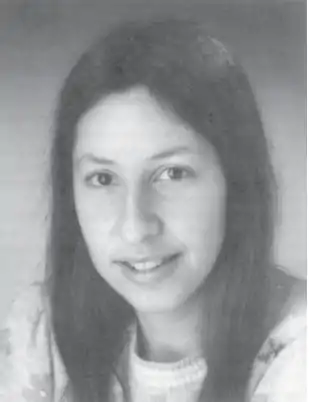Judith Young (astronomer)
Judith Young (née Rubin; September 15, 1952 – May 23, 2014)[1] was an American physicist, astronomer,[2] and educator. The American Physical Society honored Young with the first Maria Goeppert-Mayer Award for being the best young physicist in the world in 1986.[3][4][5]The Astronomer Nick Scoville of CalTech writes of her research: "Her pioneering galactic structure research included some of the earliest mapping of CO emission in galaxies followed by the most extensive surveys molecular gas and star formation in nearby galaxies."[6]
Judith Young | |
|---|---|
 | |
| Born | Judith Rubin September 15, 1952 |
| Died | May 23, 2014 (aged 61) |
| Alma mater |
|
| Awards | Maria Goeppert-Mayer Award |
| Scientific career | |
| Fields | Astronomy |
Career
Young received her Bachelor of Arts degree in Astronomy from Harvard University and graduated with Honors.[7][8] She received her M.S. and Ph.D. in physics from the University of Minnesota.[8]
Young began a postdoctoral fellowship at UMass in 1979, collaborating with Nick Z. Scoville in a study which measured the cold gas and carbon monoxide content of galaxies.[5] The pair made the discovery that the distribution of light and gas is proportional in galaxies.[5] The American Astronomical Society awarded her the Annie J. Cannon Prize for this work in 1982.[3][5]
Young became an assistant professor at the University of Massachusetts Amherst in 1985.[7] In 1989, Young was promoted to associate professor with tenure, and became a Full Professor in 1993.[7] She published more than 130 papers, mentored 5 Ph.D. candidates, and supervised 15 undergraduate research projects.[8]
Young is perhaps best known for her Sunwheel project.[9] Young's goal for this project was to bring astronomy down to earth and to an empty lot behind the football stadium at the UMass-Amherst campus.[8][9] In addition to her academic work, Young volunteered on the UMass campus and in her local community.[7][8]
Personal life
Young was born in Washington, D.C., the daughter of astronomer Vera Rubin and mathematical biophysicist Robert Joshua Rubin.[10][11]
She was married to Michael Young from 1975 to 1990[12] and had a daughter, Laura.[4]
Judith Young died from complications resulting from multiple myeloma, a disease she lived with for 8 years.[4][13]
References
- "Bio". digitalcommons.unl.edu.
- Larsen, Kristine (July 23, 1928). "Vera Cooper Rubin". Jewish Women's Archive. Retrieved July 1, 2016.
- Oakes, E.H. (2007). Encyclopedia of World Scientists. Facts on File Science Library. Facts On File, Incorporated. p. 792. ISBN 978-1-4381-1882-6. Retrieved July 1, 2016.
- "Maria Goeppert Mayer Award". APS Physics | APS Home. July 1, 2016. Retrieved July 1, 2016.
- "Obituary: Judy Young, Astronomer Who Built Campus Sunwheel". Office of News & Media Relations | UMass Amherst. May 28, 2014. Retrieved July 1, 2016.
- Teske, Richard G. (May 23, 2014). "Judith S. Young (1952 – 2014)". American Astronomical Society. Archived from the original on August 20, 2016. Retrieved July 1, 2016.
- "Obituary: Judy Young, Astronomer Who Built Campus Sunwheel". Office of News & Media Relations | UMass Amherst. Retrieved December 5, 2016.
- "Judith S. Young (1952 – 2014) | American Astronomical Society". aas.org. Archived from the original on August 20, 2016. Retrieved December 5, 2016.
- "A Megalith for the Millennium » American Scientist". www.americanscientist.org. Retrieved December 5, 2016.
- "Vera Rubin – The Gruber Foundation". Retrieved December 26, 2016.
- Sullivan, Patricia (February 5, 2008). "Robert J. Rubin, 81; Scientist Whose Work Combined Disciplines". ISSN 0190-8286. Retrieved October 26, 2018.
- Gardner, Sue Ann, "Judith Sharn Young" (1997). Faculty Publications, UNL Libraries. 115.https://digitalcommons.unl.edu/libraryscience/115
- "Judith S. Young (1952 – 2014) | American Astronomical Society". aas.org. Archived from the original on August 20, 2016. Retrieved October 26, 2018.